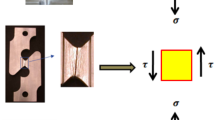Abstract
This work concerns stress and fatigue analysis of stamping tools made of cast iron with an essentially pearlitic matrix and containing foundry defects. Our approach consists at first, in coupling the stamping numerical processing simulations and structure analysis in order to improve the tool stiffness geometry for minimizing the stress state and optimizing their fatigue lifetime. The method consists in simulating the stamping process by considering the tool as a perfect rigid body. The estimated contact pressure is then used as boundary condition for FEM structure loading analysis of the tool. The result of this analysis is compared with the critical stress limit depending on the automotive model. The acceptance of this test allows calculating the fatigue lifetime of the critical zone by using the S–N curve of corresponding load ratio. If the prescribed tool life requirements are not satisfied, then the critical region of the tool is redesigned and the whole simulation procedures are reactivated. This method is applied for a cast iron EN-GJS-600-3. The stress-failure (S–N) curves for this material is determined at room temperature under push pull loading with different load ratios R = σ min/σ max = −2, R = −1 and R = 0.1. The effects of the foundry defects are determined by SEM observations of crack initiation sites. Their presence in tested specimens is associated with a reduction of fatigue lifetime by a factor of 2. However, the effect of the load ratio is more important.
Similar content being viewed by others
References
Benslima K, Penazzi L, Mabru C, Ronde-Oustau F, Rezai-Aria F (2011) A new method for advanced virtual design of stamping tools for automotive industry: Application to nodular cast iron EN-GJS-600-3. In: ESAFORM 2011, AIP Conference Proceedings, pp. 1713–1720
Lagoda T (2001) Energy models for fatigue life estimation under uniaxial random loading. Part II: verification of the model. Int J Fatigue 23(6):481–489
Griswold FD, Stephens RI (1987) Comparison of fatigue properties of nodular cast iron production and Y-block casting. Int J Fatigue 9(1):3–10
Hubner P, Pusch G, Krodel L (2004) Fatigue behaviour of cast iron with globular graphite. Adv Eng Mater 6(7):541–544
Meggiolaro MA, Castro JTP (2004) Statistical evaluation of strain-life fatigue crack initiation predictions. Int J Fatigue 26(5):463–476
Nadot Y, Mendez J, Ranganathan N (2004) Influence of casting defects on the fatigue limit of nodular cast iron. Int J Fatigue 26(3):311–319
Germann H, Starke P, Kerscher E, Eifler D (2010) Fatigue behaviour and lifetime calculation of the cast irons EN-GJL-250, EN-GJS-600 and EN-GJV-400. Procedia Eng 2(1):1087–1094
Abebe BH (2008) Fatigue life assessment of a diesel engine pump part subjected to constant and variable amplitude loading. Master thesis, Bauhaus University
Beretta S, Blarasin A, Endo M, Giunti T, Murakami Y (1997) Defect tolerant design of automotive components. Int J Fatigue 19(4):319–333
Costa N, Machado N, Silva FS (2010) A new method for prediction of nodular cast iron fatigue limit. Int J Fatigue 32(7):988–995
Firat M (2007) Computer aided analysis and design of sheet metal forming processes: part III: stamping die-face design. Mater Des 28(4):1311–1320
Ledoux Y, Sebastian P, Samper S (2010) Optimization method for stamping tools under reliability constraints using genetic algorithms and finite element simulations. J Mater Process Technol 210(3):474–486
Nilsson A, Birath F (2007) Topology optimization of a stamping die. In: NUMIFORM 2007, Conference Materials Processing and Design: Modeling, Simulation and Applications 908, pp. 449–454
Gentili A, Penazzi L, Di Pasquale E (1998) Topology optimization in sheet metal forming tool design. In: IDMME’98, pp. 449–456
Shirani M, Härkegård G (2011) Fatigue life distribution and size effect in ductile cast iron for wind turbine components. Eng Fail Anal 18(1):12–24
Oudjene M, Batoz JL, Penazzi L, Mercier F (2006) A methodology for the 3D stress analysis and the design of layered sheet metal forming tools joined by screws. J Mater ProcessTechnol 189(1–3):334–343
del Pozo D, Lopez de Lacalle LN, Lopez JM, Hernandez A (2006) Machining of large dies based on the prediction of the press/die deformation. In: Intelligent production machines and systems 2nd I*PROMS Virtual International Conference, pp. 83–88
Author information
Authors and Affiliations
Corresponding author
Rights and permissions
About this article
Cite this article
Slima, K.B., Penazzi, L., Mabru, C. et al. Fatigue analysis-based numerical design of stamping tools made of cast iron. Int J Adv Manuf Technol 67, 1643–1650 (2013). https://doi.org/10.1007/s00170-012-4597-y
Received:
Accepted:
Published:
Issue Date:
DOI: https://doi.org/10.1007/s00170-012-4597-y



